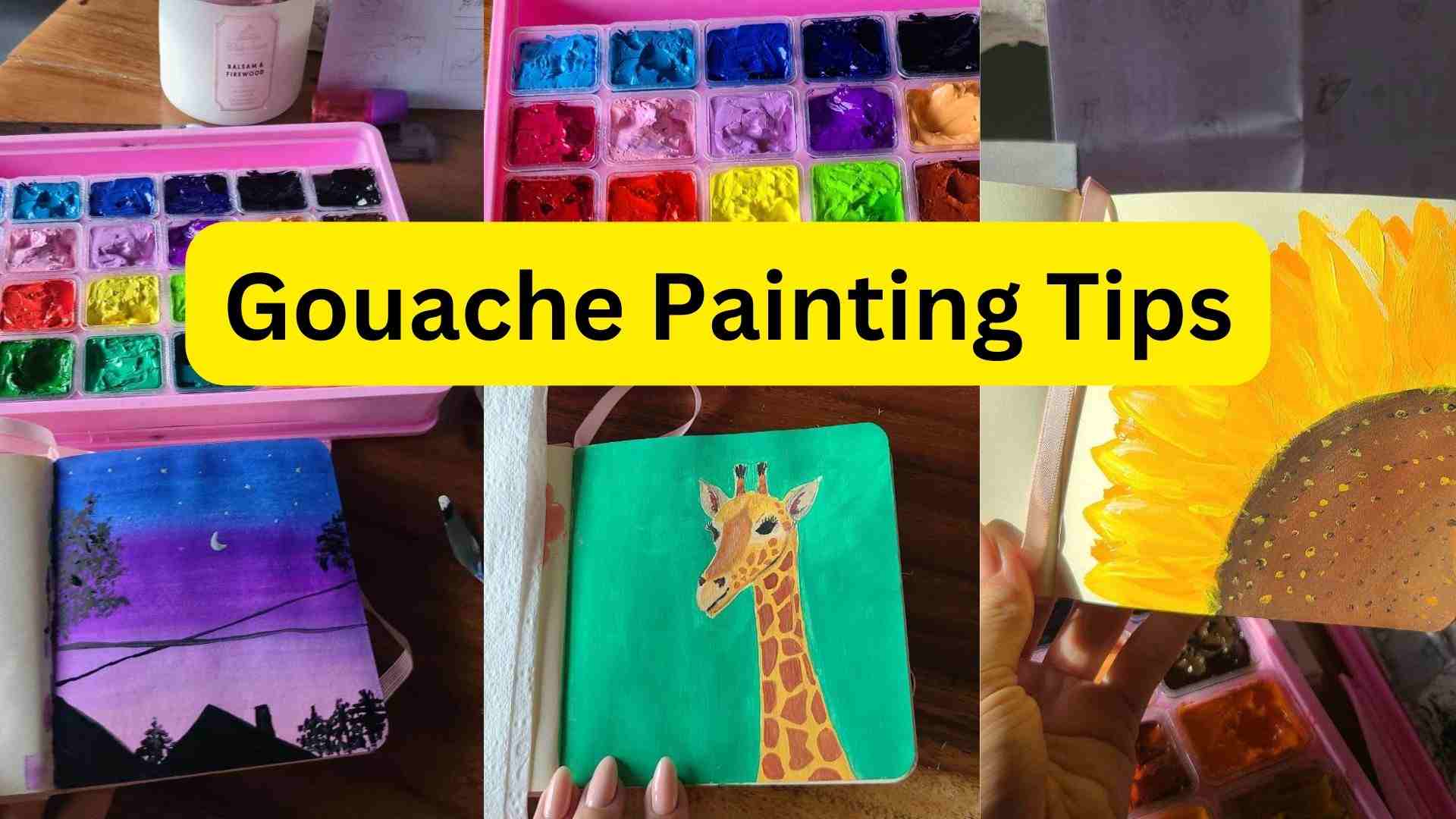Last Updated on February 10, 2024 by Masha Eretnova

In gouache painting, there is always room for improvement, and an artist should always be open to learning, especially when the gouache painting tips come from their fellow artists who have experienced quite a lot and tried different techniques.
To get better at painting with gouache practice daily paintings, use a good large mixing palette and learn color mixing, use thin layers to avoid cracking and water for smoother application, get synthetic brushes, and work with illustrations and sketches.
Grab your brushes and paint these tips on your artistic mind so you may apply them to your next Gouache Painting Project.
Table of Contents
My Gouache Painting Tips and Secrets for Beginners
Being a beginner with Gouache, learning things from other people who also do what you love is something we all treasure, mainly because it improves our skills.
That being said, we have prepared 20+ ultimate tips and secrets that a beginner in painting will need in starting their journey with Gouache Paint. I will keep updating my list if I learn something cool 🙂
Let me sum them up for you:
- Getting a smooth finish with Gouache
- Thin gouache to a creamy consistency
- Learning different techniques
- Trying different painting surface
- Bigger Brushes Bring Efficiency
- Do Not Overdo Your Work
- Practicing Daily Leads to Mastery
- Ceramic Palettes are Worth It
- Do Not Opt for Cheap Brushes
- Clean Your Paintbrush When Switching to Different Color
- Check on Your Palette to Ensure That Your Gouache is Not Drying Out
- Thick Layers of Dried Gouache May Cause Cracking and Peeling
- Make 3 types of Color Swatches
- Start Painting on a Small Scale
- Ensure that the Base Layer is Dry Enough Before Starting to work with Layers
- Gouache Paint is Different From Watercolor
- Synthetic Brushes Can Be Good For Use Too
- Enjoy and Trust The Process
- Always Varnish and Coat Your Painting
- Learn the Basics of Color Matching
- Build a Habit of Cleaning Your Brushes Regularly
As gouache is water-based as acrylic paint, you can also check my long list of tips for acrylic painting with some surprising tricks.
1. How do I get a smooth finish with Gouache?
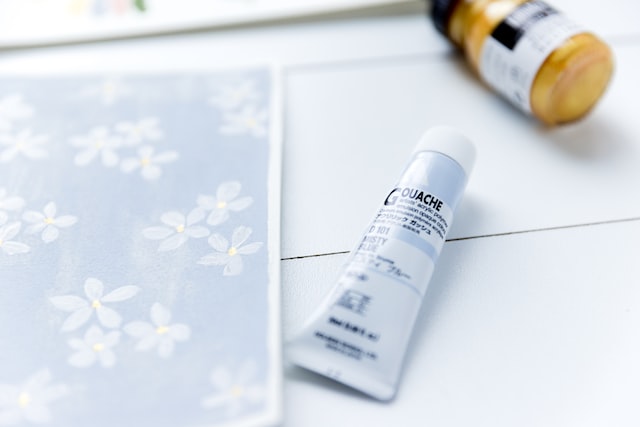
Good consistency, use of water and smooth surface will help you achieve a smoother paint application. A good brush also plays a role, as cheap brushes may leave streaks and lose hair right on the paper.
After setting up the workplace, mixing your gouache Paint is the next step in starting to prepare for your work. At the same time, it requires experience to master the consistency you want to achieve.

To achieve a smooth finish of gouache, you must know paints well and how they come off as they are because overmixing them may create a watery finish that affects the opacity of your gouache on the surface.
After mixing, make sure that your gouache has a creamy consistency that drops off slowly from your brush tip, but when it’s sticking to your brush, you’ll know it’s too thick and need more water.
If you’re painting over a rough surface like wood or raw canvas, it is better to prime it with gesso or watercolor ground. Gesso helps even the surface and gets smoother coverage.
2. How to Thin Gouache Well
Gouache thinned with water is better for painting on paper or canvas and will dry faster without cracking.
Some general tips that are useful in understanding gouache consistency:
Thick Consistency
Gouache Paint is known for its opaque and solid colors, and because they are made that way, you may not realize that it is too thick immediately.
Now, to recognize that your paint has a thick consistency, scoop an ample amount using your brush, and if the paint sticks to your brush and is hard to spread around, you will need to dilute it a little with water.
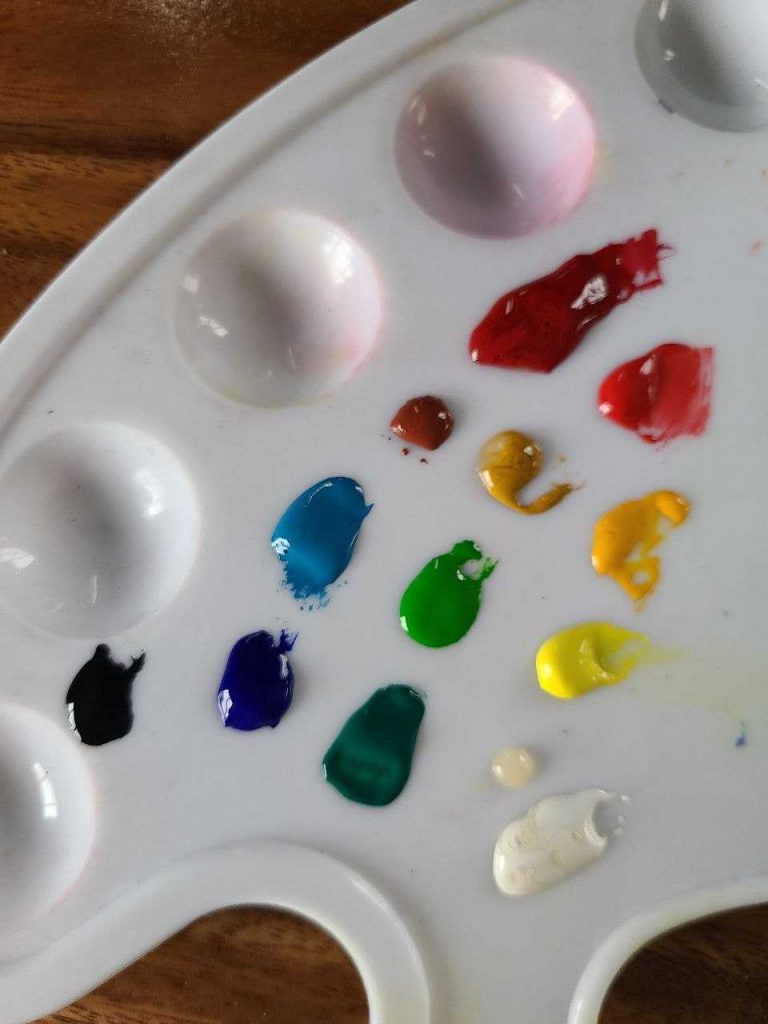
Thin Consistency
Since gouache paint is water-based, thin consistency is achieved by adding water. How to know you’ve thinned it enough?
If you notice that the surface of our mixing palette is visible, it means you have over-diluted it with water, creating a transparent finish.
Sometimes it will be enough to just spray the paint with water or use a wet brush to get a thinner application.
Check this: 15 Best Gouache Paint Sets in 2023 For Beginners and Pros
3. Learning Different Techniques
Even though gouache paint offers great creative possibilities, learning some of the most basic gouache painting techniques might be extremely helpful in understanding the medium. Some of the best to try are as follows:
Dry Brushing
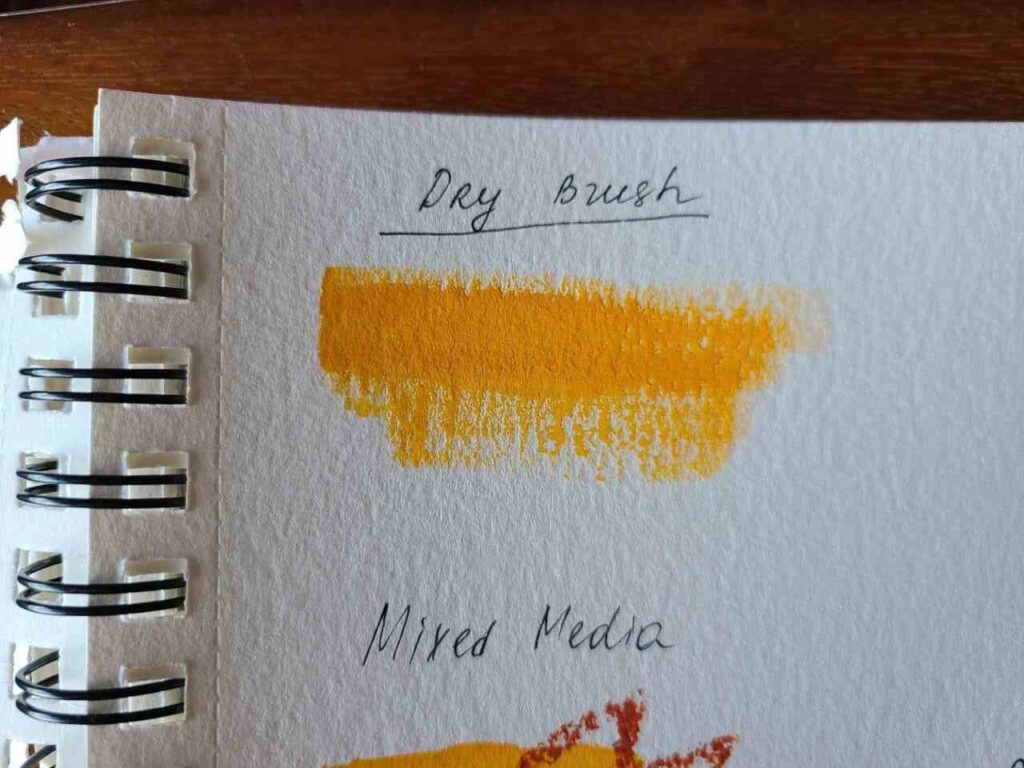
Dry brushing is a technique for adding texture to your painting and highlighting the natural paper, canvas, or wood grain you are painting on.
This approach is great for creating multi-tonal effects, fine details, backgrounds, and highlights. It also adds dark and light tones to your gouache painting. The dry brushing technique may be ideal for you if you’re into painting landscapes or natural sceneries, but I often use a dry brush for abstract.
Watercolor Imitation

Gouache is frequently compared to watercolor in appearance. Like watercolor, you can rewet gouache with water. They both use the same gum Arabic binder, though gouache has more pigment and is applied more opaquely.
But thinned with water, gouache can imitate watercolor and allows you to create portraits and illustrations with light, airy washy layers.
Wet-on-dry

Wet-on-dry painting is simply the application of wet paint directly on top of a dry surface. This is the most common technique that we all use by default without even knowing its fancy name 🙂
This technique is absolutely intuitive and universal and you can paint anything with a wet brush!
These are only 3 examples of the many techniques you can do with gouache. Check 15 more gouache techniques in my dedicated post: 18 Gouache Painting Techniques You Should Try To Paint Like Pro.
4. Trying different painting surface
Many artists prefer using gouache on watercolor paper; since gouache is a water media, it will be needing a surface that is less susceptible to warping due to absorbing too much water.

However, gouache is flexible to use on any painting surface, which is why many artists fall in love with this paint medium.
Painting gouache on glossy or oily surfaces is not suggested because they repel water-based paints.
You may try gouache on:
- Canvas,
- Cardboard,
- Paper,
- Wood,
- Illustration board, and
- Sketchbook.
5. Bigger Brushes Bring Efficiency
There is nothing wrong with using small brushes, mainly because beginners commonly use them. However, as an artist, efficiency is essential, so for applying ground or painting background use larger brushes!
Do not be afraid to use big brushes, especially when working on a big project. Though they may seem intimidating initially, you will have fun, trust me. And gouache is very forgiving, so no mistakes will ruin your work.
Of course, you will still need those small brushes, but those are only used for detailing and highlights. Both big and small brushes should be synthetic.
Choose your perfect and affordable gouache brush with my buyer’s guide: 19 Best Brushes for Gouache Reviewed by Artist [Ultimate Brush Guide].
6. Do Not Overdo Your Work
Many artists have suggested that whatever you paint, always put your heart into it.
Of course, some of us are perfectionists, and it may seem that your work isn’t done as you always will retouch it. If this is one of your frustrations as a newbie painter, learn when to stop.
- Step back from your painting. What do you LIKE about it? What you don’t like?
- If you will do something else, can it ruin it?
- Take pictures. Our art and colors look different on digital screens and it forces you to take an outside look.
- Show it on the Beginners group on Facebook and ask for critique.
- Set it aside for a couple of weeks and switch to a completely new project. Then come back and decide what you are going to do with it.
7. Practicing Daily Leads to Mastery
As an artist, it is important to improve your skills daily, as this will help you unconsciously become better than ever. You may not always want to paint, but if it is something you consider a serious hobby, set a timer for 15 minutes and just practice.
Practice doesn’t mean you need to finish a masterpiece in 15 minutes, but you can study color mixing, and shapes, try different compositions on paper (and at a small scale), and write down, or sketch some ideas.
Set a specific time of the day to draw, meditate, and introspect about the area of skills that you still need to improve. Use this time as it is sufficient time to explore your art style and techniques and expand your artistic horizons.
You may also read books, blogs, and other reference materials that could help you improve more as an artist. Most importantly, it would be best to do this with discipline and eventually notice how you have changed drastically.
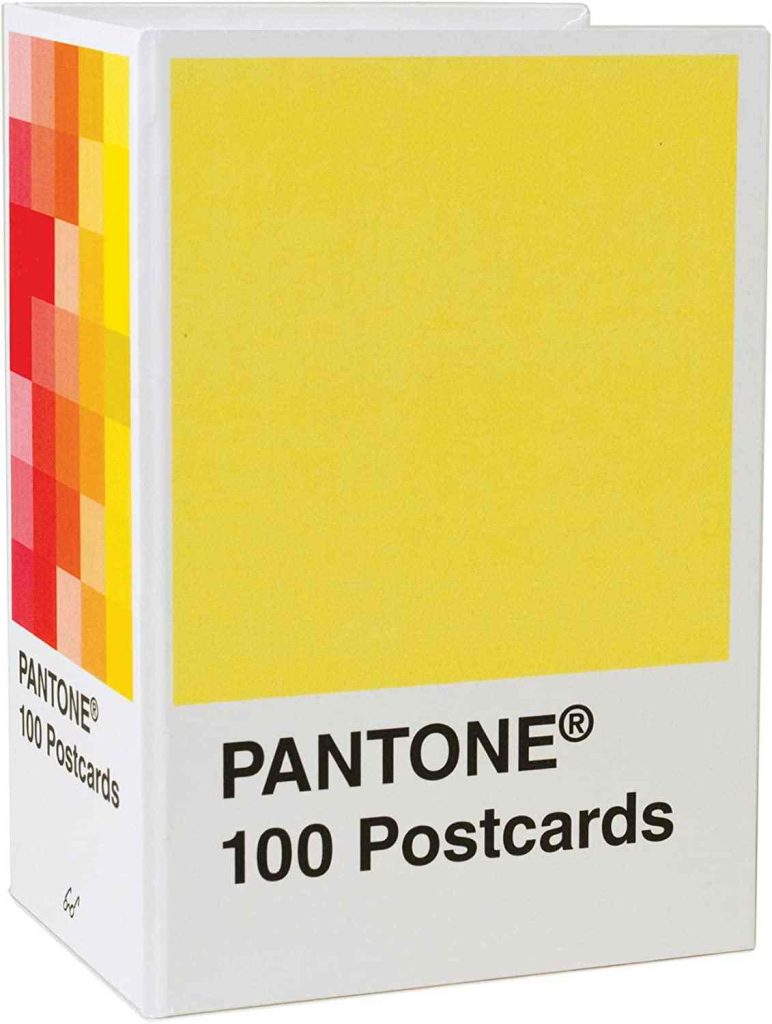
You can join (or create one yourself) a 30-day drawing or painting challenge and post a video everyday. This way your friends can hold you accountable if you miss your daily video haha 🙂
I saw one great idea – a lady decided to try gouache and she bought Pantone postcard box that comes with 100 cards. Each day she picks one, and being inspired by the color of the card, tries to create a small art. It turned out to be viral!
8. Ceramic Palettes are Worth It

A Ceramic paint palette is a good investment as they are not as easily stained as plastic, they are durable, it can be handmade. Another pro option is a glass palette or metal tray with a porcelain coating.
Though ceramic palettes are quite costly, you are guaranteed that what you pay is worth it.
Airtight containers are also a good investment as they help keep gouache fresh.
9. Do Not Opt for Cheap Brushes

Opting to buy cheap materials will only cost you more in the end, as they are easy to break and damage and the brush hairs come off quickly, making an unpleasant finish to your painting. Cheap brushes also often leave streaks.
Like opting for a ceramic palette instead of a cheap plastic palette, what you pay for is worth it with high-quality painting brushes. It would not always hurt to choose quality with your materials, such as brushes and palette, because surely, you will not regret it in the long run.
Also, cheap brush sets often come with 15 or 20 brushes, but in all honesty, you don’t need most of them. Buy good brands 2 or 3 brushes to start with (I talk in this post about what exact brushes to get) and with time expand your collection.
10. Clean Your Paintbrush When Switching to Different Color
In painting with water media such as watercolor, poster paint, acrylic, and gouache, oils, you must clean your brush in every transition since the color of the paint stays with your brush and will contaminate each other and leave mud on the paper.
To ensure that your painting will not end up looking dirty and messy and not mixing one color with another, here’s what you can do:
- Dip your paintbrush with water in a bowl.
- Pat the hairs on your paintbrush dry by using a towel. Remember to do this process gently so that you won’t be damaging the hairs on your paintbrush.
- Repeat these steps every time you change gouache colors.
Cleaning your brush in between will not only result in a neat-looking artwork but also prevent paint from accumulating in your paintbrush, reducing the risk of damaging it.
Read also: How to Clean Paint Brushes [The Ultimate Cleaning Guide]
11. Check on Your Palette to Ensure That Your Gouache is Not Drying Out
Gouache is known to be a fast-dry art medium, and when they say this, it does not only dry quickly on the art surface but also on your mixing palettes.
If you notice that your Gouache is all dried up, you can have a spray bottle beside you and mist the paint on your palette to re-activate it.
12. Thick Layers of Dried Gouache May Cause Cracking and Peeling
In painting with gouache, you must always be mindful of layering because if gouache is applied too thick, it tends to peel and crack once dry.
Thin layers are the way to go.
Another tip is to wait until the first layer is fully dry before you apply the next one, as different drying times between layers are also one of the reasons why paintings are cracking.
13. Make 3 Types of Color Swatches
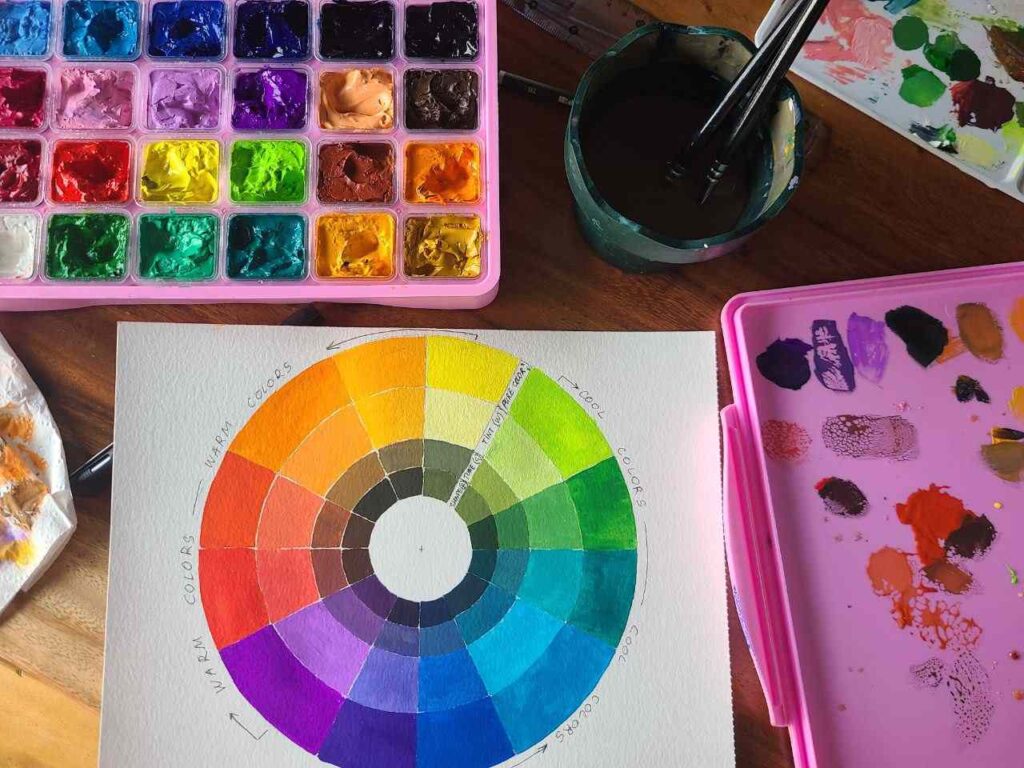
As a painter, one of the most exciting parts is restocking art materials, as it serves as a happy pill to get your materials complete once again. However, when your paint has piled up, you may get overwhelmed by the number of paints you have to deal with.
To avoid being confused by the Gouache Paints you own and to determine which one is the most suitable for your work, follow the steps below:
- Gather your Gouache Paints.
- Sort them according to the brand since the consistency and formulation differ from one brand to another.
- Reuse an old notebook, and start swatching the paints. Be mindful of putting a label like Color Code – Brand. This way, you will know what to use for your next painting project.
- You may try swatching paints in different variations:
- when diluted with water,
- when it’s straight from the tube, and
- when the paint is mixed with white so that you can see how to work with that particular paint according to the demand of your painting
- secondary and tertiary colors mixed for each brand can also be an option.
Swatches will also help you find out if this specific gouache may appear lighter or darker when it dries. Still, they can help you determine which Gouache Paint is suitable for use in a particular situation.
14. Start Painting on a Small Scale
As a newbie in painting, it is understandable that you are still figuring out your style, techniques, and preferences about the work you are doing, and beginning to paint on a small scale can help you get to big things.
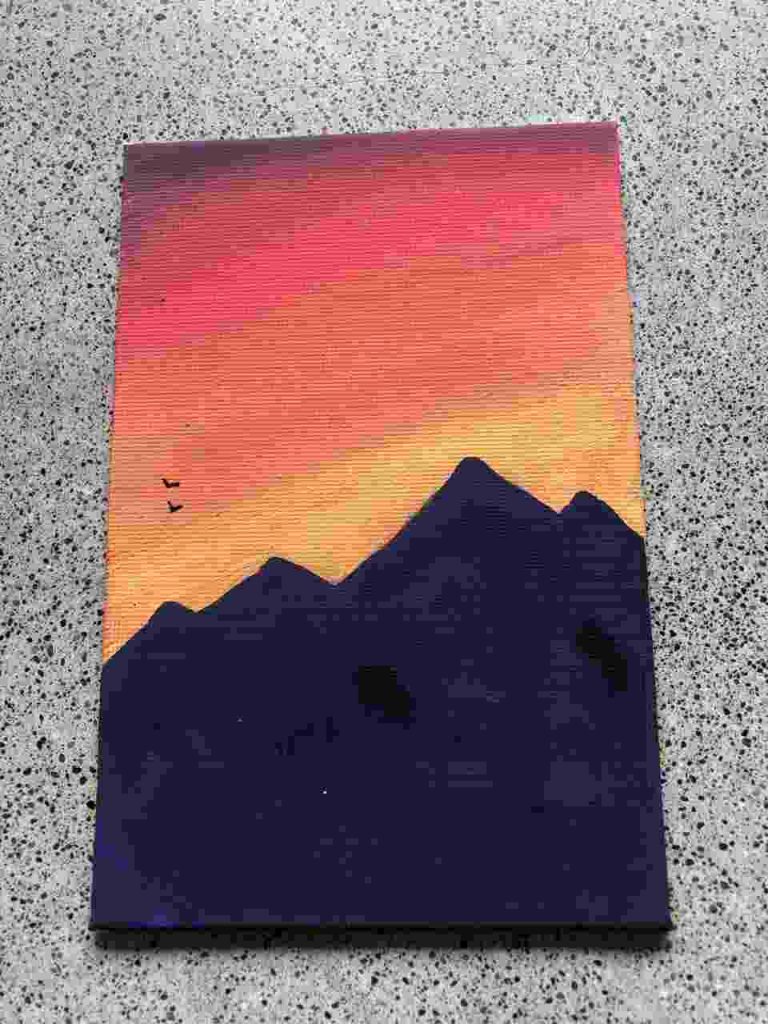
Starting to paint on small-scale canvases or paper (A5 and smaller!) can help you learn about each palette you have without entailing a lot of resources as also learning on a big canvas means you are using lots of the paints you invested in.
The small-scale painting will only require you to have a few shades by your side instead of your whole Gouache paint collection so that you won’t get overwhelmed but appreciate and enjoy painting your artwork.
15. Ensure that the Base Layer is Dry Enough Before Starting to work with Layers
Working with any water media requires waiting for the base layer to dry up completely before applying the second layer. One good thing about gouache is that it dries quickly.
However, Gouache also reacts with water quickly, as it gets re-activated instantly when contacted with water, resulting in color bleeding.
So always wait for layers to dry, and try not to overdo the next layers with water.
16. Gouache Paint is Different From Watercolor or Acrylic

Artists often compare Gouache and watercolor, and beginners are often confused about interchanging them. So the tendency is that they treat gouache as how they treat watercolor paints.
The distinction between Gouache and Watercolor is the opaqueness of gouache. Remember the following consistency tips:
- Diluting Gouache with too much water will create a watery consistency, making it look like watercolor.
- Gouache can be used and often is used opaquely and thickly, unlike watercolor.
Read more: Gouache Paint vs Watercolor: How do they differ and which is best?
Gouache is also different from Acrylic as acrylics become water-resistant and cannot be reactivated while gouache is always sensitive to water. If you are switching from gouache to acrylic or vice versa please adjust your techniques.
Read more: Gouache Vs Acrylic: Major Difference Between Gouache And Acrylic
17. Synthetic Brushes Are the Best
Many artists agree that Synthetic brushes can be better for gouache than natural brushes.
Synthetic brushes do not always mean cheap brushes, though. In choosing synthetic brushes, you may bend the hair to see how the bristles respond when bent.
Additionally, the ability of synthetic paint brushes to hold water is less than that of natural hair brushes. With a synthetic brush, you may control the amount of water in your painting to avoid being messy, which is perfect for gouache.
Read also: 19 Best Brushes for Gouache Reviewed by Artist [Ultimate Brush Guide]
18. Enjoy and Trust The Process

Painting with any water media will require extra patience compared to painting with non-water media such as oil pastels, as gouache needs time to quick before applying another layer and extra caution with water.
To paint efficiently using gouache, you may follow the process of painting with Gouache:
- In painting the base layer, you may want to start tracing blocks of color before filling them with paint to create boundaries so you may paint effortlessly.
- It would be helpful to take time with your application for the second and subsequent layers because the base layer will still have to blend with subsequent layers.
- In working with layers, it is also important to work from light to dark colors, so you can more easily paint dark paint over light ones instead of vice versa because it would be difficult to paint light over dark. Especially if you work with washes
- Applying the same principle above with shapes, pro painters also say that it’s best to start by painting the bigger shapes and then doing smaller shapes on top, which allows the bottom layers of color and design to show through still.
19. Protect Your Painting
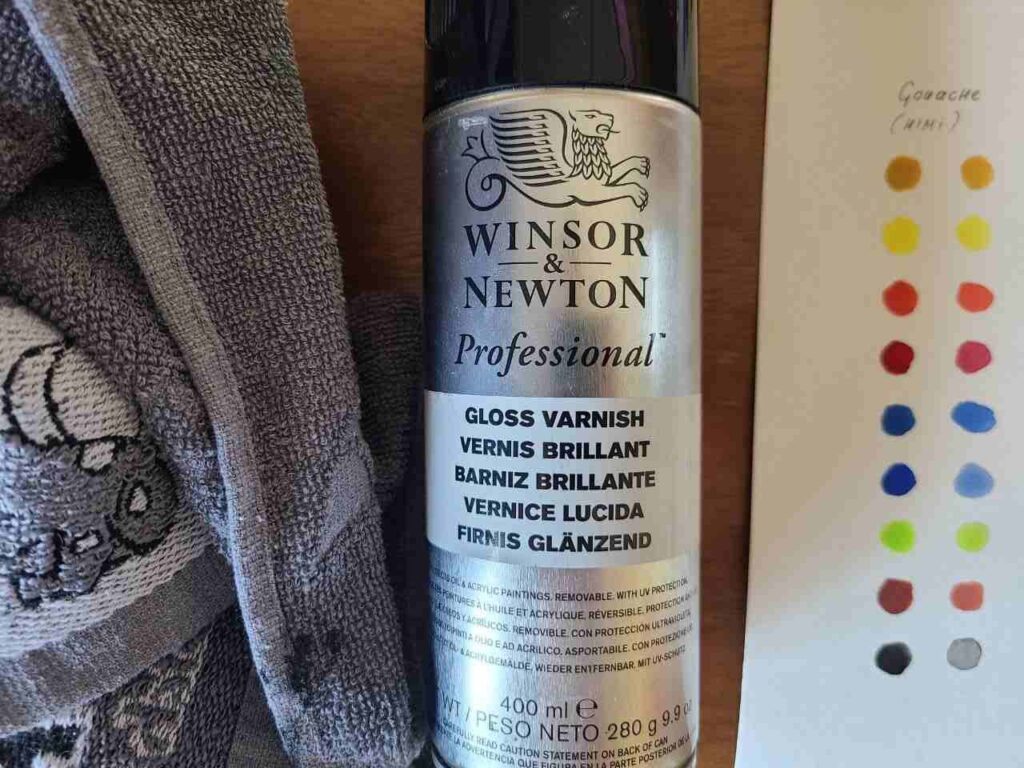
Unlike acrylic or oil paintings that require varnishing, many pro painters skip varnishing gouache. Instead, they put it under glass or plexiglass. The key is to protect finished gouache painting from water, as we now know, even a drop will reactivate the paint and practically ruin your work.
However, not everyone is a fan of paintings under the glass, so painters found a way of varnishing gouache too. There are various ways to seal your painting, and these are as follows:
- Watercolor varnish: If you keep the artwork for a personal collection, you could use this technique. You may refer to this article about varnishing a gouache painting.
- Isolation Coat: If you sell your Gouache Paintings, then a more serious way of sealing is needed, and you must use an acid-free layer of varnish to ensure a solid protective barrier.
To top off the varnishing of your Gouache Painting, placing it in a glass frame is highly suggested, as it serves a double purpose of protecting your paint and making it more eye-pleasing for display.
Read also: Best Isolation Coat for Acrylic Painting: Is It Necessary?
20. Learn the Basics of Color Theory
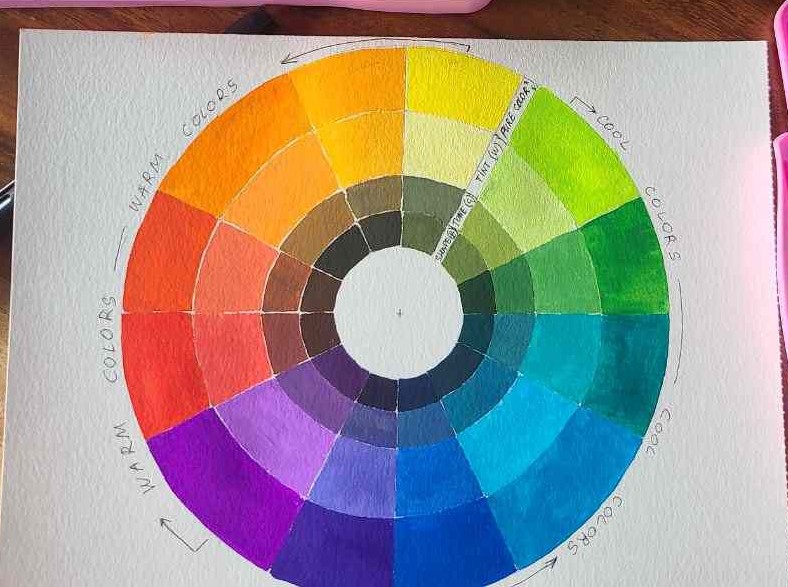
As a beginner in painting, learning the basics of the color wheel is sometimes overlooked due to the overwhelming information you have to learn about painting with gouache.
To mix different colors with gouache you will follow the same rules as for any other medium (acrylic or watercolor). Primary colors like red, blue, and yellow will create secondary colors when mixed, and so on.
Learn basic color theory with me: Your Complete Color Mixing Guide
In most gouache sets though you will have all the needed colors and you may only have to make them lighter (with
However, it’s always best to try mixing colors with the basic colors red, blue, yellow, and white. Doing so will help familiarize you with colors and ultimately save you money. You can buy fewer tubes of better brands.
Always be mindful of the color wheel to ensure that your piece’s colors are complementary. Lastly, do not be afraid to use bold colors, as this emphasizes your painting.
21. Build a Habit of Cleaning Your Brushes Regularly
When you use your brush frequently, the tendency is that the debris of gouache paint will accumulate and eventually damage the bristles of your paintbrush when neglected.
To avoid this, do not allow the Gouache paint to dry on the brush for a long time before cleaning it, so it is best to clean your paintbrush after every use.
To clean your brush, we have listed an effective method to clean your paintbrushes:
- Gather your brushes that need cleaning.
- Prepare lukewarm water and mild dish soap.
- Wet the debris of paint in your brushes using lukewarm water.
- To remove the slimy feel in your brush, the paint has left off your brush, apply a mild dish soap and wash it well until the debris is gone.
- Rinse the brush thoroughly.
- Pat your brush/es with paper towels and let them air dry on their own, and do not directly dry them in the Sun as it may damage your brush.
How do I Get Better at Gouache Painting?
In anything we do, regardless of what it is, improvement takes a lot of courage, discipline, and hard work. The same applies to painting with Gouache, as nothing comes easily.
As a beginner, you may be overwhelmed with many things you have yet to learn, and now you have questions about how to get better at Gouache Painting.
Learning is a Personal Responsibility
Many artists are self-thought, which is why it is important to learn about the basic elements of art, such as tones, edges, movement and rhythm, and color, to continually improve and master your craft.
Remember that learning is always your accountability, and do not deprive yourself of learning deeply about your craft, as this is one of the secrets that shape a good artist.
Start with Cultivating Your Drawing Skills to Master your Painting Skills
Many beginners often get overwhelmed with painting because there is a misconception that painting is stressful, challenging, and only for those with gifted hands.
However, it is important to perceive painting as an expression rather than work, as this can bring out the best in you, especially in your creativity. Improving your drawing skills leads to mastery of your painting skills.
Suppose you create a daily habit of practicing drawing; this will drastically improve how you do your paintings, specifically with Gouache. Draw anything that inspires you, seek it for a mentor, and socialize with fellow artists.
Be Observant With Your Surroundings
Artists are gifted to observe things profoundly and meaningfully; that is why they can express themselves through their work in the most earnest way possible.
One way to improve your Gouache Painting skills is to determine your way of appreciating the beauty around you. Once you get the gist, you can transform the mundane into something beautiful, using elements such as colors, shadows, and shapes.
Always see yourself as being profound, as this will help you explore yourself and how you will creatively express it on your canvas because the only limit there is in art is your imagination.
Remain Committed to Practice
Learning does not come instantly. Investing your resources in training and practice is worth it, especially in painting. As for painting, watching someone paint is not always enough because unless you can do it yourself, you will be able to master it.
Always apply the art lessons you have learned according to your art style as soon as possible so you won’t forget them. Only then will you see the desired results? Always remember to trust the process because all of it will be worth it.
Allotting at least 30 minutes of your time daily can make you go places. Afterward, mastery will follow because of your commitment to learning and self-growth as a painter because you chose not to remain stagnant but to improve continuously.
Wrapping Up
Painting with Gouache can be a little intimidating, especially for those who are just beginning to try them out or are just getting started with their painting journey. Things like these can get intimidating until you try them and see that it isn’t that bad.
In this article, we have imparted 20+ tips that you may utilize in practicing Gouache as your next medium.
With this handful of tips, we hope you have gained a fair knowledge about painting with Gouache, even though you are still a beginner.

Masha Eretnova, born in 1991, is a Buenos Aires-based certified teacher, artist, and member of the Professional Artist Association with 20+ years of personal painting journey.
She started painting and drawing very early and is now an international abstract artist and educator passionate about acrylic painting, gouache, and crafts.
Her works are part of international exhibitions and contests, including ArtlyMix (Brazil), Al-Tiba 9 (Spain), Exhibizone (Canada), Italy, and many more.
Besides her artistic pursuits, Masha holds a post-grad diploma in Teaching Film Photography and 2 music school diplomas: piano and opera singing.
